Savory Bread Pudding
Bread pudding is a quintessential Real Food. At one time or another cooks of every culture that eat bread, eggs and milk have had a little of all of them left over, and one creative cook put them all together, threw in some dried fruit and baked it until it puffed and served it for breakfast on a cold morning.
An instant favorite, it has been handed down through generations, modified to habitats and tastes. For years my favorite version was made with pears caramelized in sugar, sliced almonds and a little almond extract served with hot maple syrup. I admit to having that as a one-course dinner more than just a few times.
One day when I was writing my cookbook I thought about my grandmother’s version of cheese soufflé and it occurred to me that caramelized onion with good aged cheese would be a tasty and beautiful bread pudding partner for pheasant. So I began to play with different cheeses and Walla Walla Sweet onions. The recipe that was included in the book is one of the most often commented upon since the book was published.
Savory bread puddings are easy to make, provide a good flavor base for cheeses and herbs and offer a creative alternative to potatoes or rice. Made in individual ramekins, they cook faster than in a larger pan and eliminate the done on the edges and runny in the middle that has happened to most cooks.
Last week I had a gorgeous rack of lamb and wanted to complement it with something that would balance the meat’s richness with a sophisticated base flavor and interesting, multiple flavors. Somehow the soft texture of bread pudding with an ashy pecorino (semi soft, not salty Romano) and sautéed wild Morels (reconstituted) with a little chopped, fresh tarragon for its earthy licorice flavor seemed right. Using ramekins guaranteed that everyone would get morels.
Two chops from the rack, some fresh, almost crunchy asparagus splashed with lemon juice and olive oil and a golden browned, bubbly individual wild morel and Pecorino Fresca bread pudding.
Today I decided to experiment with six different savory bread puddings: one with Mexican flavors, one with sun dried tomatoes, one with sage and leeks, one with Feta and Kalamata olives, one with a distinctive, aged cheese and the morel and pecorino one from last week.
Basic Savory Bread Puddings
Serves 4 (6oz. ramekins)
Hints
- Soft commercial breads that work well for sweet bread puddings cook too light for savory puddings. I recommend day old artisan or French bread with the crust included.
- For individual puddings, the golden browned tops is its pretty part, so if you are cooking for guests use straight sided ramekins because they will stand up better when they are removed from the dish to be served on the dinner plate. If it’s just family, small glass Pyrex bowls work well.
- Butter the inside of the ramekins before filling them. Run a dinner knife around the edge and slip a rubber spatula in one side to transfer the puddings to each plate. Oil does not work as a substitute.
- Another important plus for ramekins: portion control!
Ingredients
4 tsp. unsalted butter, room temperature
2 large slices of day old artisan bread cut into 1” cubes with crust on
2 large eggs
1 pint half and half (not the fat free version)
Unsalted butter (room temperature) for lining the ramekins
¼ cup chopped fresh herbs plus 4 sprigs or leaves for garnish
6 oz. good cheese (different cheeses are specified for each of the 6), grated with medium cut.
Procedure
- Rub butter on the entire inside of each ramekin. Put bread cubes into ramekins, about 8+- cubes per ramekin. Set aside
- Mix eggs and milk in processor or with electric mixer until well blended and foamy. Set aside.
- Sprinkle 2 tsp. herbs over bread cubes. Sprinkle 4 oz. cheese over bread and mix gently with a fork to disperse the herbs and cheese evenly among the bread cubes. Pour the egg mixture among the ramekins, gently pressing the bread cubes into the liquid. Sprinkle medium grated cheese over the top of each ramekin.
- Let prepared ramekins absorb the liquid for at least 30 minutes and up to several hours (covered and refrigerated). Put ramekins in baking pan. Add 1” hot water. Bake in preheated 375º oven for 20 minutes.
- Puddings are done when the tops are dark golden brown and the sides are bubbling. Remove from oven and carefully remove ramekins from water using tongs or a heat protective towel. Let stand for 5 minutes before removing puddings from ramekins. Transfer puddings from ramekins to warmed serving plates, garnish and serve.
Mexican
Aged Monterey Jack cheese, cilantro, ½ tsp. sliced garlic clove per ramekin, ¼ tsp. ground cumin per ramekin, thinly sliced Poblano chili, chopped red bell pepper, ½ tsp. Green Tabasco per ramekin.
Sun Dried Tomato
per ramekin: 1 tbs. mashed sun dried tomato, 1 tbs. fresh tomato (no juice or seeds), 1 tbs. finely chopped fresh basil, 1 tbs. fresh Ricotta cheese. Cheese: Parmegiano Reggiano
Sage and Leek
If full size leeks, clean, slice and blanch 1” of leek per ramekin. Cheeses: 1 tbs. fresh Ricotta, Pecorino Fresca (Tuscano). Fresh sage.
Feta and Kalamata Olive
per ramekin: 2 sliced Kalamata olives, 1 tsp. Feta cheese, ½ tsp. sliced garlic clove, rosemary and Pecorino cheese.
Morel
per ramekin: 2 medium large reconstituted Morels, chopped; ½ tsp. fresh tarragon, chopped; 1” sliced leek or ½ tsp. chopped shallot. Pecorino Fresca.
Aged Cheese
1” of leek per ramekin, fresh Italian parsley, cheese: hard aged artisan cheddar.


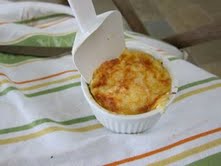

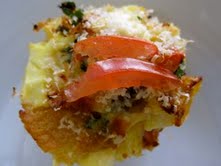
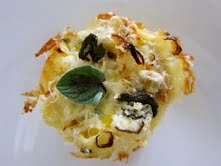
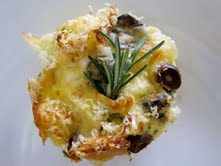
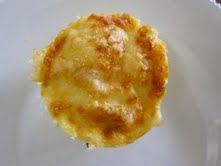
Pingback: Tweets that mention Six Flavors of Savory Bread Pudding | Fresh by Northwest -- Topsy.com